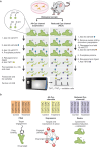Multifaceted Proteome Analysis at Solubility, Redox, and Expression Dimensions for Target Identification
- PMID: 39120068
- PMCID: PMC11481203
- DOI: 10.1002/advs.202401502
Multifaceted Proteome Analysis at Solubility, Redox, and Expression Dimensions for Target Identification
Abstract
Multifaceted interrogation of the proteome deepens the system-wide understanding of biological systems; however, mapping the redox changes in the proteome has so far been significantly more challenging than expression and solubility/stability analyses. Here, the first high-throughput redox proteomics approach integrated with expression analysis (REX) is devised and combined with the Proteome Integral Solubility Alteration (PISA) assay. The whole PISA-REX experiment with up to four biological replicates can be multiplexed into a single tandem mass tag TMTpro set. For benchmarking this compact tool, HCT116 cells treated with auranofin are analyzed, showing great improvement compared with previous studies. PISA-REX is then applied to study proteome remodeling upon stimulation of human monocytes by interferon α (IFN-α). Applying this tool to study the proteome changes in plasmacytoid dendritic cells (pDCs) isolated from wild-type versus Ncf1-mutant mice treated with interferon α, shows that NCF1 deficiency enhances the STAT1 pathway and modulates the expression, solubility, and redox state of interferon-induced proteins. Providing comprehensive multifaceted information on the proteome, the compact PISA-REX has the potential to become an industry standard in proteomics and to open new windows into the biology of health and disease.
Keywords: auranofin; immunology; interferon; lupus; mass spectrometry; oxidation and reduction.
© 2024 The Author(s). Advanced Science published by Wiley‐VCH GmbH.
Conflict of interest statement
The authors declare no conflict of interest.
Figures




References
-
- Savitski M. M. F., Reinhard F. B. M., Franken H., Werner T., Savitski M. M. F., Eberhard D., Molina D. M., Jafari R., Dovega R. B., Klaeger S., Kuster B., Nordlund P., Bantscheff M., Drewes G., Science 2014, 346, 1255784. - PubMed
-
- Molina D. M., Jafari R., Ignatushchenko M., Seki T., Larsson E. A., Dan C., Sreekumar L., Cao Y., Nordlund P., Science 2013, 341, 84. - PubMed
-
- Gaetani M., Sabatier P., Saei A. A., Beusch C. M., Yang Z., Lundström S. L., Zubarev R. A., J. Proteome Res. 2019, 18, 4027. - PubMed
-
- Sabatier P., Beusch C. M., Saei A. A., Aoun M., Moruzzi N., Coelho A., Leijten N., Nordenskjöld M., Micke P., Maltseva D., Tonevitsky A. G., Millischer V., Villaescusa J. C., Kadekar S., Gaetani M., Altynbekova K., Kel A., Berggren P. O., Simonson O., Grinnemo K. H., Holmdahl R., Rodin S., Zubarev R. A., Nat. Commun. 2021, 12, 6558. - PMC - PubMed
MeSH terms
Substances
Grants and funding
LinkOut - more resources
Full Text Sources
Research Materials
Miscellaneous
